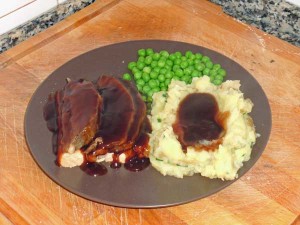By Richard Thomas
Whether it be for a roast, making a meat pie, or jazzing up leftovers, beef gravy is a staple of old fashioned, meat-and-potatoes cooking. One way to put a new spin on that classic sauce is to add a little bourbon to it.
Ingredients
3 tbsp Flour
Butter, oil, or water
1 qt of beef stock or roasting pan run-off liquid
Salt
1/4 cup of red wine
1 shot of bourbon whiskey
Making gravy starts with roux, a thickening agent made of flour and usually something neutral and fatty, like melted butter or vegetable oil. In a small mixing bowl, add melted butter or oil to your flour and stir until you have a thick, consistent paste. If you need a low fat version, simply substitute water an add enough to stir the flour into a creamy mixture. For a thicker gravy, make more roux.
Pour the beef stock or beef run-off into a pot, and stir in the roux. One advantage of having properly liquified the flour is that it won’t clump up into mini-dumplings when it comes into contact with the hot beef liquid. Place over medium-high heat and start stirring. Pour in the red wine, the bourbon, and add salt to taste, stirring constantly as the gravy comes up to a boil and thickens. Once the gravy is thick and consistent, it’s ready.
The result is a gravy that is noticeably, but moderately alcoholic, and also one where the wine and bourbon flavors enhance the full-bodied flavor of the beef gravy. It’s a little tart, a little sweet, a little vanilla-ish, and a little woody on top of being velvety and savory. For this article, I whipped up some gravy for a diner classic: open-faced roast beef sandwiches with mashed potatoes (depicted).
I used Town Branch bourbon in the photographed example, but once again, I believe the choice of whiskey used in cooking matters only insofar as the alcohol content is concerned. You can tell the difference between using a 60% abv cask strength and a more normal 40 or 45% abv whiskey (using a cask strength for cooking would be a sin besides), but not between say, Town Branch and Maker’s Mark. Once it’s in the pot, the subtleties that make a difference when you’re drinking it are lost. My advice is to nice and reasonably priced with your cooking whiskey, but avoid the super cheap, low grade stuff.
 The Whiskey Reviewer A World of Whiskey, Poured Every Weekday
The Whiskey Reviewer A World of Whiskey, Poured Every Weekday

